
Fishery can mean either the enterprise of raising or harvesting fish and other aquatic life or, more commonly, the site where such enterprise takes place. Commercial fisheries include wild fisheries and fish farms, both in freshwater waterbodies and the oceans. About 500 million people worldwide are economically dependent on fisheries. 171 million tonnes of fish were produced in 2016, but overfishing is an increasing problem, causing declines in some populations.

The goal of fisheries management is to produce sustainable biological, environmental and socioeconomic benefits from renewable aquatic resources. Wild fisheries are classified as renewable when the organisms of interest produce an annual biological surplus that with judicious management can be harvested without reducing future productivity. Fishery management employs activities that protect fishery resources so sustainable exploitation is possible, drawing on fisheries science and possibly including the precautionary principle.

A fishing trawler is a commercial fishing vessel designed to operate fishing trawls. Trawling is a method of fishing that involves actively dragging or pulling a trawl through the water behind one or more trawlers. Trawls are fishing nets that are pulled along the bottom of the sea or in midwater at a specified depth. A trawler may also operate two or more trawl nets simultaneously.
The Northwest Atlantic Fisheries Organization (NAFO) is an intergovernmental organization with a mandate to provide scientific advice and management of fisheries in the northwestern part of the Atlantic Ocean. NAFO is headquartered in Halifax, Nova Scotia, Canada.

The Scottish Fisheries Protection Agency (SFPA) was an Executive Agency of the Scottish Government. On 1 April 2009, the Scottish Fisheries Protection Agency and Fisheries Research Services were merged with the Scottish Government Marine Directorate to form Marine Scotland, part of the core Scottish Government.
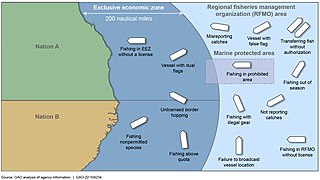
Illegal, unreported and unregulated fishing (IUU) is an issue around the world. Fishing industry observers believe IUU occurs in most fisheries, and accounts for up to 30% of total catches in some important fisheries.

Vessel Monitoring Systems (VMS) is a general term to describe systems that are used in commercial fishing to allow environmental and fisheries regulatory organizations to track and monitor the activities of fishing vessels. They are a key part of monitoring control and surveillance (MCS) programs at national and international levels. VMS may be used to monitor vessels in the territorial waters of a country or a subdivision of a country, or in the Exclusive Economic Zones (EEZ) that extend 200 nautical miles (370.4 km) from the coasts of many countries. VMS systems are used to improve the management and sustainability of the marine environment, through ensuring proper fishing practices and the prevention of illegal fishing, and thus protect and enhance the livelihoods of fishermen.
Catch reporting is a part of Monitoring control and surveillance of Commercial fishing. Depending on national and local fisheries management practices, catch reports may reveal illegal fishing practices, or simply indicate that a given area is being overfished.
The South East Atlantic Fisheries Organisation (SEAFO) is an organization that maintains controls over fishing and fishing related acts in the Southeastern Atlantic Ocean.
A fisheries observer is an independent specialist who serves on board commercial fishing vessels, or in fish processing plants and other platforms, and is employed by a fisheries observer program, either directly by a government agency or by a third party contractor. Observers spend anywhere from 1 day to 3 months out at sea before returning to be “debriefed”. A debriefing consists of reviewing any unusual occurrences or observations, violations observed, and any safety problems or other hardships they endured during the trip. These data are then integrated into the regional agency’s database used to monitor fish quotas.

China has one-fifth of the world's population and accounts for one-third of the world's reported fish production as well as two-thirds of the world's reported aquaculture production. It is also a major importer of seafood and the country's seafood market is estimated to grow to a market size worth US$53.5 Billion by 2027.
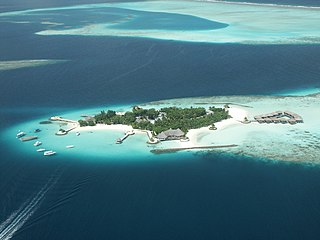
The fishing industry in the Maldives is the island's second main industry. According to national tradition in the words of former President Maumoon Abdul Gayoom, "Fishing is the lifeblood of our nation, it is inborn. From the soil on which we live, to the sea around us, it remains an integral part of our existence. Fishing, and our country and its people, [are] one and shall remain inseparable forever." The Maldives has an abundance of aquatic life and species of fish. Common are tuna, groupers, dolphin fish, barracuda, rainbow runner, trevally and squirrelfish and many more. Aside from being of essential importance to the economy, fishing is also a popular recreational activity in the Maldives, not only among locals but by tourists. The islands have numerous fishing resorts which cater for these activities.
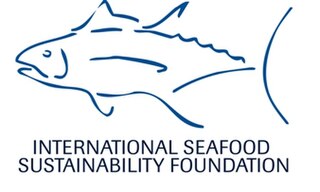
International Seafood Sustainability Foundation (ISSF) was formed in 2009 as a global, non-profit partnership among the tuna industry, scientists and World Wide Fund for Nature. The multistakeholder group states its mission is "to undertake science-based initiatives for the long-term conservation and sustainable use of tuna stocks, reducing bycatch and promoting ecosystem health". Regional Fisheries Management Organizations (RFMOs) are primarily responsible for managing the world's tuna stocks—skipjack, yellowfin and albacore tuna, the species most commonly processed for canned and shelf-stable tuna products, but their parliamentary procedures too often allow the short-term economic and political interests of nations to prevent sustainable measures from being adopted. ISSF works to ensure that effective international management practices are in place to maintain the health of all the tuna stocks.
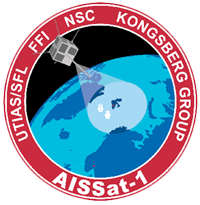
AISSat-1 is a satellite used to receive Automatic Identification System (AIS) signals. Launched on 12 June 2010 from Satish Dhawan Space Center as a secondary payload, AISSat-1 is in a sun-synchronous low Earth orbit. Initially a development project, the satellite has since passed into ordinary operations. Via downlinks at Svalbard Satellite Station and at Vardø Vessel Traffic Service Centre it tracks vessels in the Norwegian Sea and Barents Sea for the Norwegian Coastal Administration, the Norwegian Coast Guard, the Norwegian Directorate of Fisheries and other public agencies.

The Pacific Islands Forum Fisheries Agency (FFA) is an intergovernmental agency established in 1979 to facilitate regional co-operation and co-ordination on fisheries policies between its member states in order to achieve conservation and optimum utilisation of living marine resources, in particular highly migratory fish stocks, for the benefit of the peoples of the region, in particular the developing countries. The office campus is located in Honiara, Solomon Islands
The Fisheries Monitoring Centre is a specialised unit within the Irish Naval Service responsible for sea fisheries protection and surveillance of all fishing vessels equipped with a Vessel Monitoring System. All Irish vessels operating inside and outside of the Irish EEZ are monitored by the FMC, as are all internationally registered vessels operating inside the Irish EEZ.
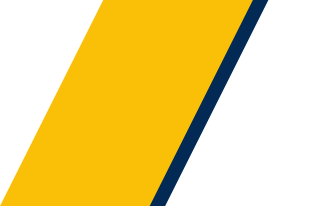
The Directorate General of Marine and Fisheries Resources Surveillance is a government agency under the management of the Ministry of Marine Affairs and Fisheries of Indonesia. Formally established on 23 November 2000 according to Presidential Decree No. 165/2000, the PSDKP is the agency responsible for supervising the marine and fishery resources of the Republic of Indonesia. The main mission of PSDKP is the prevention of Illegal, unreported and unregulated fishing in Indonesian waters, which has caused a substantial loss for Indonesia's fishing industry. In its mission to prevent illegal fishing, PSDKP has conducted joint-operations with the Indonesian Navy, Water Police, Sea and Coast Guard, the Maritime Security Agency and Customs. PSDKP is however is not associated with these agencies.
Illegal, unreported and unregulated fishing (IUU) in the Arctic is an under researched scientific field. The most recent academic articles about IUU in the Arctic mainly concerns the mid-2000s.
Transshipment or transhipment at sea is done by transferring goods such as cargo, personnel, and equipment from one ship to another. It is a common practice in global fisheries and typically takes place between smaller fishing vessels and large specialized refrigerated transport vessels, also referred to as “reefers” that onload catch and deliver supplies if necessary.

The Integrated Coastal Surveillance System (ICSS) is a coastal surveillance system operated by India with the goal to protect its coastline, ensure regional security, and assist friendly navies by quickly detecting, locating and monitoring maritime activity in the Indian Ocean. The system was developed by the Defence Research and Development Organisation (DRDO) and Bharat Electronics, and forms part of the National Command Control Communication and Intelligence System (NC3I). Although the ICSS was built primarily for coastal and maritime security, the system can also be used for vessel traffic management, harbour surveillance and navigation. The core of the ICSS is a network of remote ground-based radar stations called the Coastal Surveillance Network (CSN). In addition to radars, stations are also fitted with optical sensors, electro-optical sensors, thermal imagers, cameras, meteorological systems, an Automatic Identification System (AIS), a distress alert transmission system (DATS), electronic warfare support measures, and very high frequency (VHF) radio communication systems.














